|
The
Development of Local Government
Before the 19th century the most
common form of local government was a combination of
local Justices of the Peace, who administered the powers
of the Crown, and the local parish Vestry, the decision
making body that was named after the room where meetings
took place.
Vestry meetings were attended by
the parish ratepayers, who not only looked after the
spiritual, but also the physical welfare of parishioners
and their parish amenities. They levied and set the
local rates and taxes, and took responsibility for the
care of the poor, repair of the roads, law enforcement,
church repairs, and appointed parish officers such as
parish constables, and overseers of highways, and
overseers of the poor.
They also carried out the duties
required by the poor law. Under the terms of the Poor
Law Act of 1601, each parish was responsible for its own
poor, and the distribution of poor relief, which was
funded by the poor rate. This was levied on property
owners and tenants.
The Vestry oversaw the running of
the Willenhall’s workhouse, founded in 1741, until the
poor law was replaced by Poor Law Unions in 1834, as a
result of the Poor Law Amendment Act. The workhouse
closed in 1839, by which time the administration of the
poor was in the hands of the Board of Guardians for the
Wolverhampton Union of Parishes. The poor of the town
were then sent to the Union Workhouse in Wolverhampton.
The Public Health Act of 1848 gave
powers for the setting-up of public health boards, which
led to the formation of the Willenhall Local Board of
Health in 1854. The first meeting took place on 18th
September, 1854 in the Literary Society’s room in
Stafford Street. Those present were Richard Foster,
Jeremiah Hartill, Joshua Froysell, W. Hodson, R. Butler,
Jonah Hartill, G. Morgan, and G. Robinson. James
Tildesley was in the chair. Ralph D. Gough was appointed
chairman at a subsequent meeting on the 2nd October.
The initial objectives of the board
were concerned with improving the health of the
population by providing a clean water supply, sewers,
street lighting, and a municipal burial ground. At this
time the administrative functions of the town were
shared between the Vestry, the Justices of the Peace,
and the Local Board, which must have been an
administrative nightmare.
In order to simplify local
government, the Local Government Board was created under
the terms of the Local Government Board Act of 1871 to
oversee all local government matters. Simplification
continued under the terms of the Public Health Act of
1872 which divided the country into local sanitary
areas, and extended the power of local authorities. This
led to the Willenhall Local Board of Health becoming the
Willenhall Urban Sanitary Authority.
At this time Willenhall became
smaller. The citizens of Short Heath had previously
petitioned the Local Board to separate from Willenhall.
As a result Short Heath became a separate Urban Sanitary
District with its own Local Board, which became Short
Heath Urban District Council in 1894. The two areas were
separated until they were reunited as a result of the
Staffordshire Review Order on 1933, when Willenhall also
took over a small part of Bentley.
Willenhall acquired its first
council, Willenhall Urban District Council, in 1894 as a
result of the 1892 Local Government Act. There were 16
members, elected on 17th December, 1894. The first
chairman was Jesse Tildesley.
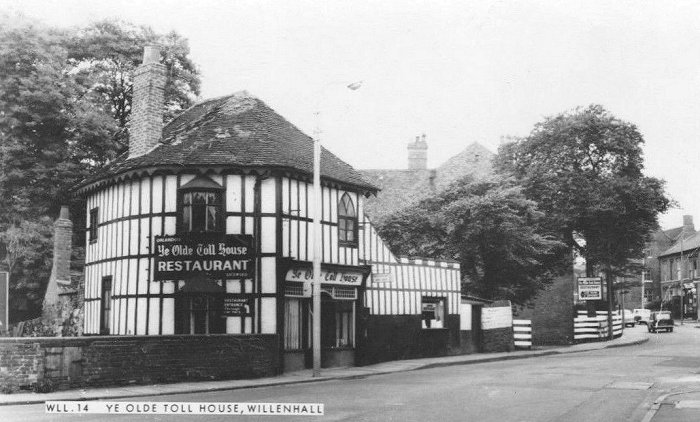
From an old postcard.
The
Library |
|

The library in Clemson Street. |
By this time the council controlled
many local services including the library. Willenhall
had a library very early on, thanks to the efforts of
the Willenhall Literary Institute, a voluntary
organisation founded by a group of public spirited men.
In 1866 the organisation funded the building of the
library in Clemson Street. As well as the library the
building included, study rooms, a lecture hall, offices,
and committee rooms.
In July 1874 the local authority
decided to adopt the 1850 Public Libraries Act which
enabled town councils to establish public libraries, and
stated that access to libraries should be free of
charge. In 1875 the literary institute transferred its
building and contents to the local authority for use as
a public library. The first librarian of the free
library was David Marsh.
The Urban Sanitary Authority held its meetings in the
committee rooms, and levied a rate of one penny in the
pound to cover the running costs, supplemented by rent
for the rooms. The building, which became Willenhall’s
first Town Hall continued to be used by the local
authority until the new town hall was built in Walsall
Street. |
| In 1921 the library received a legacy of £100
from the late Jesse Tildesley which was used to
purchase books for a reference library. Within a few
years the open access system was adopted so that
borrowers could directly examine the contents of the
library, rather than requesting books from the
catalogue.
The stock increased after a grant of £450 given
by the Carnegie United Kingdom Trust. By the mid
1930s the library had around 18,000 books, and a
reading room was made available to the public. |

Forest Gate Branch Library. |
| A separate juvenile lending department was
opened, and thanks to the appointment of a
full-time librarian and assistants, the lending
departments opened all day. The opening hours
were 10.00 a.m. until 7.30 p.m. except on
Wednesdays when the library closed at 1.00 p.m.
The minimum age for children was 8 years old,
and the junior department closed at 6.00p.m. The
Library Committee joined the Regional Library
Scheme for the Midlands, so that any book not in
the library, could be obtained from another
library within 14 days. In 1948 a branch
library opened at Holy Trinity School in Coltham
Road, and operated until 1960 when it was
replaced by Forest Gate Branch Library at New
Invention.
A New Town
Hall |
|
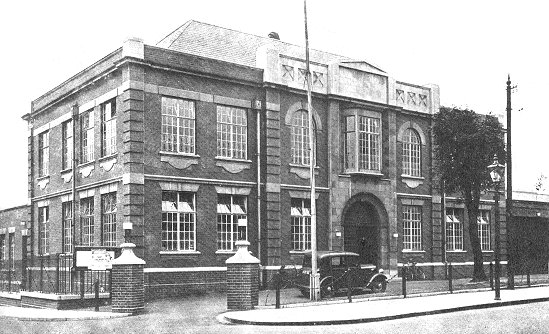
The new Town Hall, now the library. |
The new Town Hall was built in 1934/35 on the site
of the Old Hall. A foundation stone was laid by Mr. G.
G. Evans, J.P. Chairman of the council, and on 20th
March, 1935 the completed building was opened by the
Countess of Harrowby, wife of the Lord Lieutenant of
Staffordshire.
It was built at a cost of £11,749. |
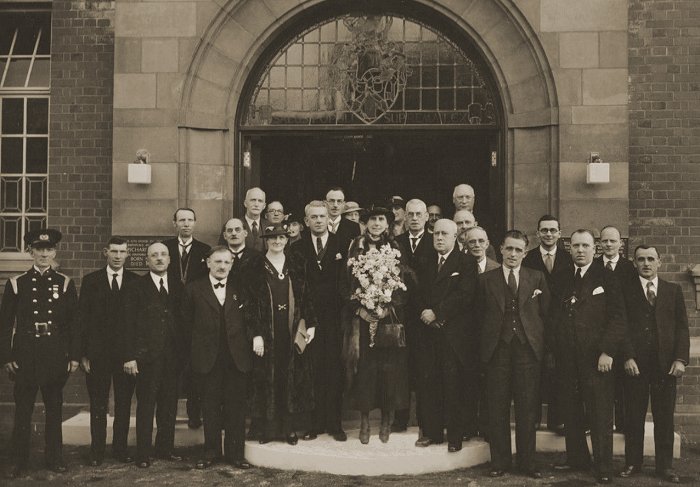
The official opening of the Town Hall on
20th March, 1935. From an old postcard.
|
The building contained a
well-proportioned council chamber, panelled in teak, and
matching teak furniture. It had excellent acoustic
properties, and also contained committee rooms, an
assembly room, and offices for all council departments.
Attached to the building was the fire station, which
housed the town’s fire fighting equipment, and in the
adjacent yard was a garage containing the town’s
ambulance, a gift from Reginald Tildesley in memory of
his parents.
Fire fighting in Willenhall was
originally in the hands of the town surveyor, and the
roadmen. The fire engine had to come from Wolverhampton.
On the 12th of December, 1887 the Local Board decided to
form, and equip, a fire brigade consisting of 12
volunteers. People quickly volunteered, and by early
January the first twelve members had been
selected. They were:
| W. Chesney, G.
Ecroyd, G. Goodchild, T. Green, M. Jobborn,
A. Law, E. Lucas, J. Lucas, E. Raybone, E.
Seckington, R. W. Stockham, and J. Tyler.
|
Captain of the fire brigade was the
town surveyor, Mr. Baker. The first fire station
consisted of a roofed-over recess between two buildings
in Upper Lichfield Street. The fire fighting equipment
included a handcart, 2 standpipes, 100 yards of hose, 2
jets, and 12 uniforms, each consisting of a helmet, a
belt, a badge, and an axe. Mr. Baker was soon replaced
as captain by J. H. James, who repeatedly asked the
Local Board more equipment and better accommodation.
An escape ladder was provided, but the volunteers
still felt that their equipment was inadequate for the
job in hand, and so they locked-up the fire station,
handed-in the keys, and walked away. Eventually they
were persuaded to return, but a fire engine was not
purchased until May 1896.
Willenhall's first fire engine was
built by Shand, Mason & Company of 75 Upper Ground
Street, Blackfriars Road, London. It cost £145 and could
deliver water at a rate of 100 gallons a minute, and
send it up to 120 feet in the air.
|
|
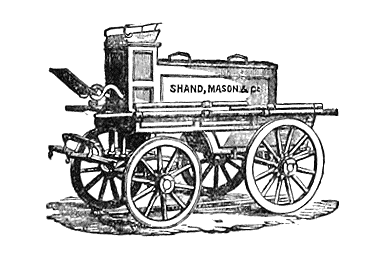
A Shand, Mason & Company's
manual fire engine. |
The new fire engine, which was called "Nil
Desperandum" proved its worth two years later during
one of the largest fires in the town. On Friday
the 16th of July, 1899 a large fire started in
Thomas Tildesley's timber yard in Railway Lane at
about half past four in the afternoon. With the help
of fire brigades from Wolverhampton, Bilston, and
Wednesbury, the fire was under control by 9 o'clock
in the evening. It had caused around £2,000 worth of
damage.
This, and several other fires, highlighted the
importance of the fire engine, and the need for a
much better steam-powered machine. |
| In December 1900 the council agreed to spent
£700 on the purchase a steam fire engine, 1,000
yards of hose, a double set of horse harnesses, and
alterations to the fire station. It would be paid
for by adding an extra halfpenny to the rates. By
this time the fire station was next to the Town Hall
in Clemson Street.
In those days the fire brigade's services were
not free. If they put out a fire, the owner of the
damaged property would be charged for each man's
time, any expenses incurred, refreshments for the
men, and any damage that was done to appliances or
uniforms. |
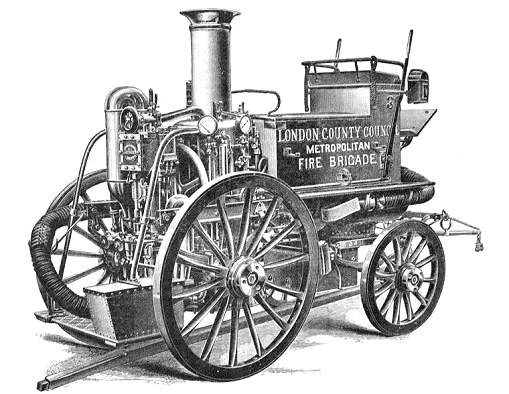
A Shand, Mason & Company's
steam fire engine. |
|
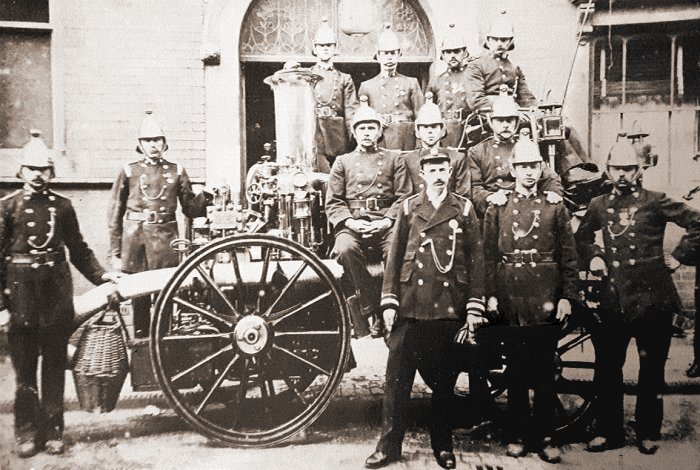
Willenhall Fire Brigade.
From an old postcard. |
|
In 1903 an electrically operated
fire alarm was installed, which was later connected to
alarms in the firemen's houses. Twelve years late it was
updated, and eight alarms were placed in various parts
of the town. In 1916 this was augmented by the use of
the factory hooter at John Harper's. The fire brigade
acquired its first motorised fire engine in 1922 which
could pump up to 500 gallons of water a minute. A second
motorised engine was acquired in 1928, and in 1934/5 the
brigade moved to a new fire station in Walsall Street,
next to the new Town Hall. In 1948 the brigade became
part of Staffordshire Fire Brigade. In 1966 it
joined Walsall Fire Brigade, after Willenhall became
part of Walsall Metropolitan Borough. In 1974, with the formation of the West Midlands,
it became part of West Midlands Fire Service. In 1981
the brigade moved to a new fire
station in Clarkes Lane, which is still there today.
In April 1934 Willenhall was
reunited with Short Heath, and the number of councillors
increased to 21. The wards were as follows:
|
Ward |
Number of
Councillors |
|
Portobello |
4 |
| St.
Anne’s |
4 |
| St.
Giles |
4 |
| St.
Stephen’s |
4 |
|
Short Heath |
5 |
| |
|
|
|

The Town Hall. From an old
postcard. |
| Behind the Town Hall was the Public Baths, erected
at a cost of £25,000 in 1938/39. The foundation stone
was laid by Mr. W. Johnson, Chairman of the Public Baths
Committee on 24th September, 1938. The building was
opened on 15th April, 1939 by Councillor J. A. Parkes,
J.P. Chairman of the council.
The building contains a 75ft. long by 36ft. wide
swimming pool, varying in depth from 7ft. 6inches to
3ft. 6 inches, and holding 80,000 gallons of water.
There was a slipper baths, and also a spring-maple floor
which could be placed over the swimming pool to convert
the building into an assembly hall. In the winter months
it was used for dances and variety shows, and throughout
the year exhibitions and demonstrations were held there.
|

The baths set up for wrestling. |
| The assembly hall seated 800 people on the ground
floor, and 150 on the balcony, and had a fully equipped
stage for theatrical events. The building, which later
became Willenhall Leisure Centre, closed on 27th
August, 2010.
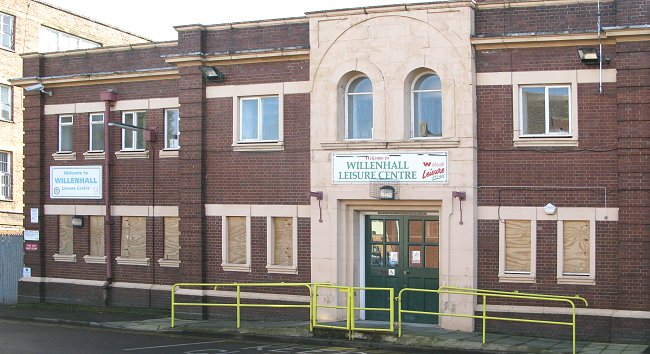
Willenhall Leisure Centre.
In 1966 Willenhall lost its status as an
urban district under the terms of the Local Government
Reform Act, and became part of Walsall Metropolitan
Borough. At the same time Portobello became part of
Wolverhampton.
In 1969 the library moved to the ground floor of the
Town Hall, which by then had been vacated by the
council. The Clemson Street building was then
demolished.
Education
As in most Black Country towns,
education in Willenhall began in church schools where
children were given a basic religious education, and
encouraged to attend church services. By the 1820s there
was a Wesleyan Day School, and later a Primitive
Methodist School which opened in King Street in 1837. By
1842 the British School had opened in King Street, and
another British School could be found in Little London.
In
1853 the Church of England sponsored the National
Schools which opened at the junction of Lower Lichfield
Street and Doctor’s Piece in 1853. The school continued
in use until 1908 when St. Giles School opened in
Walsall Street. |

St. Giles Church of England Primary School in
Walsall Street.
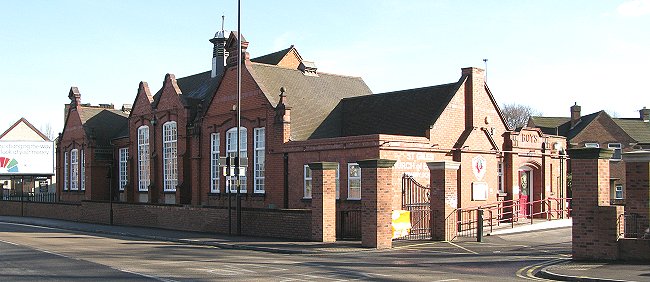
Another view of St. Giles School.
|
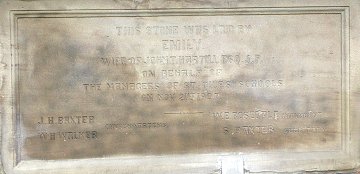 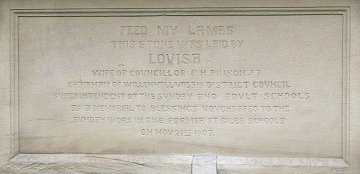
Two of the foundation stones at
the front of St. Giles School. |
|
There are three foundation stones
on the front of St. Giles School, which were laid on 21st
November, 1907. One was laid by Emily Hartill, wife of
John Hartill, on behalf of the managers of St. Giles
Schools; another was laid by Louisa Pinson, wife of C.
H. Pinson, Chairman of Willenhall Urban District
Council, and Superintendent of the Sunday and Adult
Schools; and the third was laid by Mary Ethel Vaughan,
daughter of Henry Vaughan, J.P.
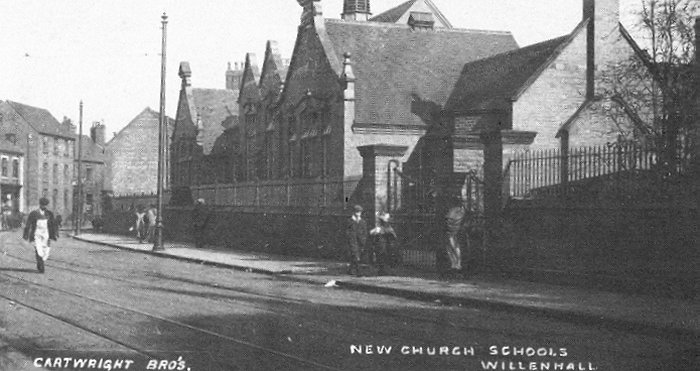
St. Giles School. From an old postcard.
The 1870s saw the formation of the
Willenhall School Board, created under the terms of the
1870 Elementary Education Act. School Boards provided
elementary education for children aged 5-12, and
financed themselves through the local rates. Parents
still had to pay fees for their children to attend
school, but school boards could pay the fees of children
who were from poor families. At the time, school
attendance was not compulsory, and remained so until
1880. The 1891 Education Act did away with fees, making
elementary education free.

The Central Schools which opened
in 1883. Latterly Little London Primary School, which
closed in 2007.
Five schools were built in
Willenhall between 1879 and 1890 to provide sufficient
places for all the children in the town. School boards
were abolished under the terms of the 1902 Education
Act, and replaced by Local Education Authorities.
Education in Willenhall then came under the control of
Staffordshire County Council, which became the Local
Education Authority.

Lane Head School in
1956. It was built as Short Heath Board
Schools in 1880. It is now Lane Head Nursery
School. |
Willenhall is well served today by
a number of schools. Primary schools include St. Giles C
of E Primary School in Walsall Street, Woodlands School
in Bloxwich Road North, Short Heath; Lakeside Primary
School in Holman Close; Clothier Street Primary School
in Harry Perks Street; Beacon Primary School in Davis Road;
Pool Hayes Primary School in Bridgnorth Grove; and last
but not least, Fibbersley Park Primary School in Noose
Lane. Secondary schools include Willenhall Comprehensive
School which opened in September1955 and later moved to
a larger site in Furzebank Way, now known as Willenhall
School Sports College; Sneyd Community College in Vernon
Way, which specialises in maths and computing; and the
Thomas More Catholic School, which is in Darlaston Lane.
|
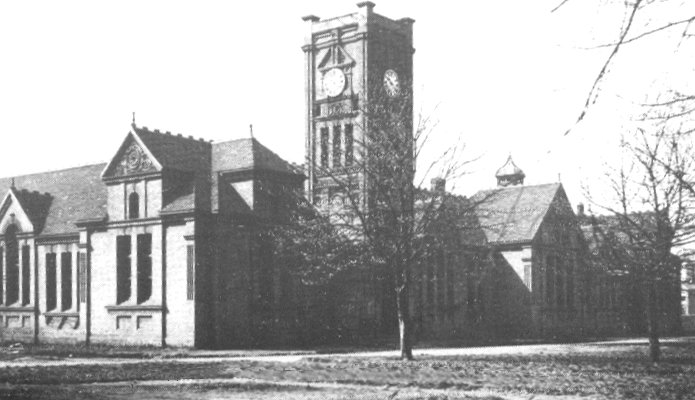
Another view of
Central Schools. From an old postcard. |
|

An earlier view of
Central Schools. From an old postcard. |

Group 6 from Walsall
Road Council School that stood on the corner
of Walsall Road and Crescent Road. From an
old postcard. |
Parks Willenhall’s first public park was the Short Heath
Playing Field, opened in 1919 by Short Heath Urban
District Council.
This was soon followed by the Memorial Park which was
opened on Saturday 30th September, 1923 by Mr. T. Kidson,
chairman of the War Memorial Committee. The committee
raised a total of £10,043, by public subscription, to
cover the cost of building the park |
|
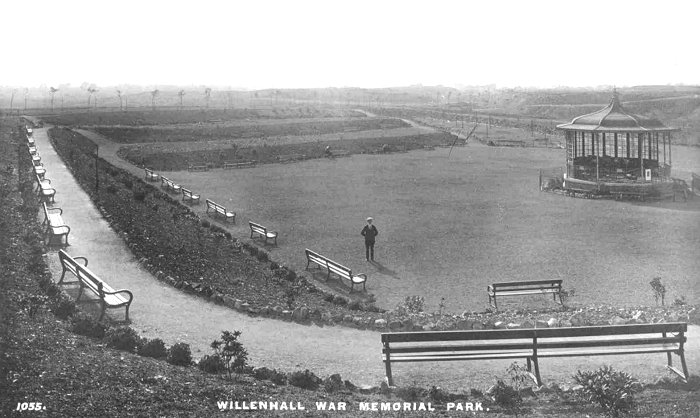
An early view of the park. From an
old postcard. |
|
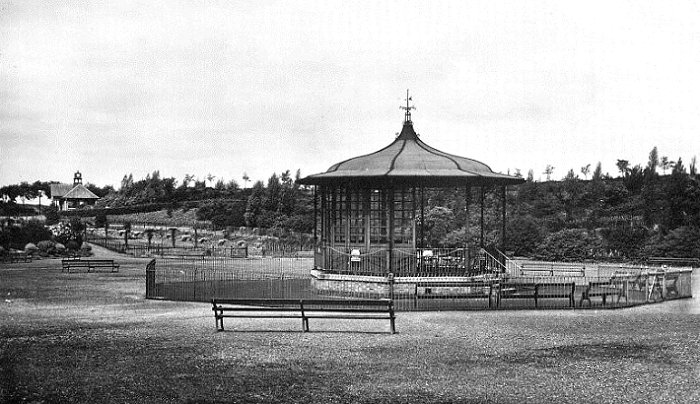
Another early view. From an
old postcard. |
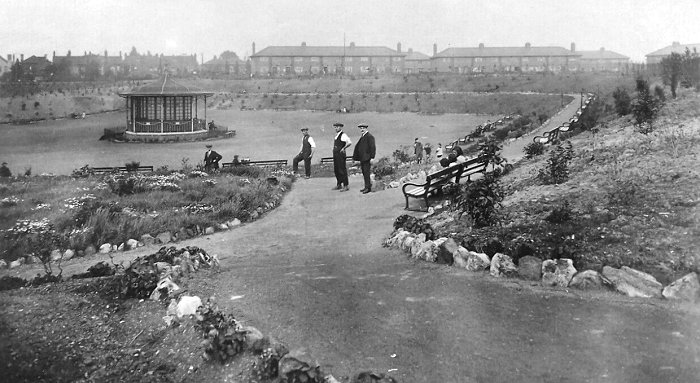
Another early view. From an
old postcard.
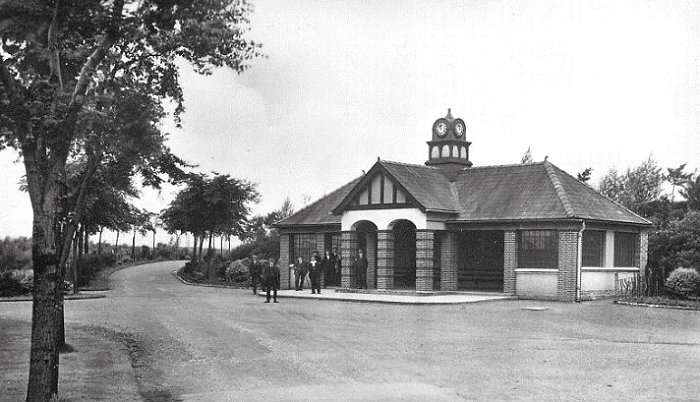
The Pavilion. Also from an old postcard.
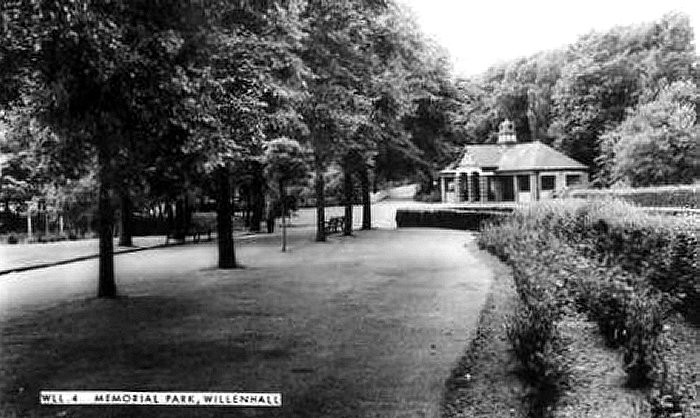
The Pavilion. From another old postcard.

The tennis courts. From an old postcard.
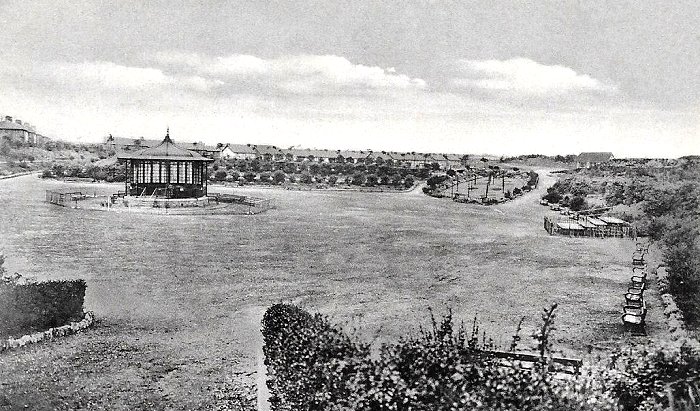
The area around the bandstand in the early
days. From an old postcard.
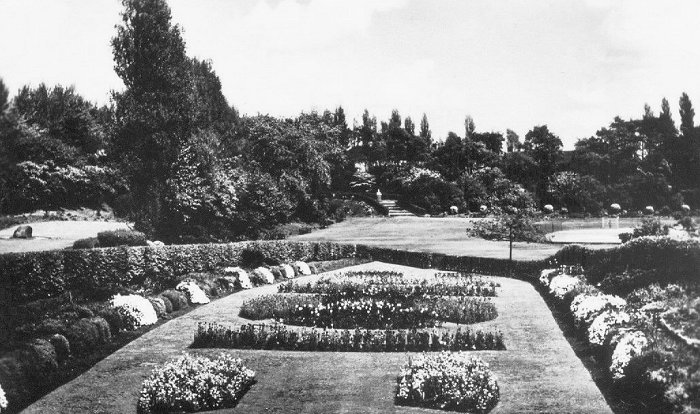
A more recent view with mature flower
beds. From an old postcard.

The lake in the Memorial Park.

The bandstand.
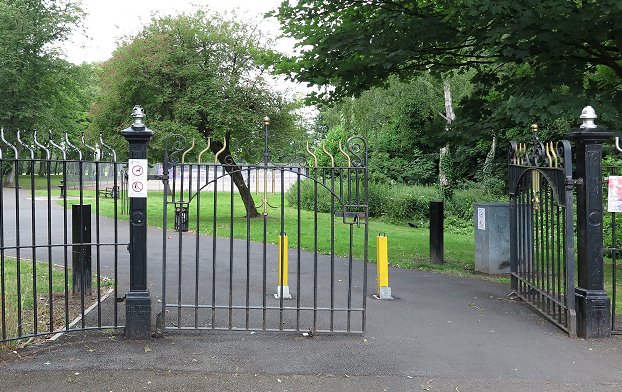
The fencing and park gates were made by E.
C. & J. Keay Limited of Darlaston.
| Work on the park began in 1917 following a grant of
£7,145 from the Unemployment Grants Committee that had
been formed to provide employment for ex-servicemen.
They were paid £1 a week to work on the park, which
originally covered nearly 33½
acres, and is a memorial to the local people who lost
their lives in the First World War. The park was built on a piece of derelict land, covered with old mine
workings and slag heaps. It was landscaped, and included
tennis courts, a bowling green, a playing area, and a
paddling pool. After World War 2 the park was extended
by the addition of another 17 acres. Land was also
acquired in Bilston Lane and Shepwell Green to provide
two open public spaces. |
 |
|
 |
|
 |
Return to
Coal Mining |
|
Return to
the contents |
|
Proceed to
Life in
the 19th century |
|